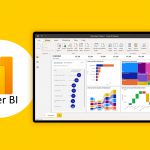Businesses looking for more reporting power and analytical muscle than that offered by Excel, often steer toward business intelligence tools. Designed by Microsoft, Power BI is the name for a collection of apps and services that help organizations collate, manage, analyze, and visualize data from a variety of sources.
A Closer Look at Power BI
Power BI offers the Report Builder for creating shareable, paginated reports. For companies that can’t have or don’t want this information online, the Report Server is an on-premises report generator.
Data from multiple business data sets feed into Power BI, are processed, and then turned into intelligible insights. The results often use visually compelling and easy-to-process charts and graphs that help businesses visualize what happened in the past, what’s currently happening, and predict what might happen in the future.
The estimate models provided by Power BI allow businesses to generate forecasts. With these forecasts, businesses can adequately prepare to meet future demand and other key metrics.
Who Uses Power BI?
Power BI is primarily used by business intelligence professionals for creating data models and reports which are then shared throughout their organization. However, since not all businesses have business intelligence professionals on their payroll, Power BI is often used as a self-service tool by employees from a variety of departments.
The user-friendly interface of Power BI makes it easy to use, even by non-technical staff. There are also Power BI developers who specialize in the development and administration of this tool.
Components of Power BI
Power BI is a collection of apps, each with its own features and uses. The major components of this tool are:
- Power Query: a data connection tool that lets you transform, combine, and enhance data from several sources
- Power Pivot: a data modeling tool for creating data models
- Power View: a data visualization tool that generates interactive charts, graphs, maps, and other visuals
- Power Map: another visualization tool for creating interactive geographical visualizations
- Power Q&A: a question-and-answer engine that lets you ask questions about your data in plain language
- Data management gateway: offers periodic data refreshers, view data feeds, and expose tables
The user-friendly nature of Power BI makes it easy to learn how to create Power BI dashboards. In addition to the core components, other data sources can be connected to Power BI including files systems (e.g., Excel, PDF, SharePoint Folder, and XML), database management tools (e.g., SQL Server Database, Oracle, IBM, Amazon Redshift, and Google BigQuery), Azure data connections, and other online services. This flexibility has made Power BI one of the most utilized tools by business intelligence professionals.
Power BI Elements
Unlike most data management tools, there are several variations of Power BI designed to be used on different platforms.
- Power BI Desktop is a free version of Power BI intended for small to midsize businesses. It is used to create new models and reports from scratch.
- Power BI Service is a paid online cloud-based service where Power Bl data models, reports, and dashboards are hosted. Unlike the desktop version, administration, sharing, and collaboration are performed online.
- Power BI Data Gateway was created to bridge the gap between the Power Bl Service and other on-premise data sources such as DirectQuery, Import, and Live Query.
- Power BI Report Server is an on-premises solution for premium users. It is similar to Power BI Service but is deployed on-premises with the desktop app.
- Power BI Mobile Apps are available for Android, iOS, and Microsoft mobile devices. They can be used to view reports and dashboards on the Power Bl Service Report Server.
- Power BI Embedded is a white-label version of Power BI that allows independent software vendors to integrate the software into their apps, rather than build their own analytical tools from scratch.
Why Businesses Need Power BI
Power BI is a secure and reliable tool that allows businesses—irrespective of their industries—to connect data sources in the cloud or on-premises and get real-time updates on business operations. Businesses can make more informed decisions by using the insights provided by Power BI in their operations and performance. In addition, this tool offers easy deployment, hybrid configuration, and a secure environment for the management of enterprise data.



